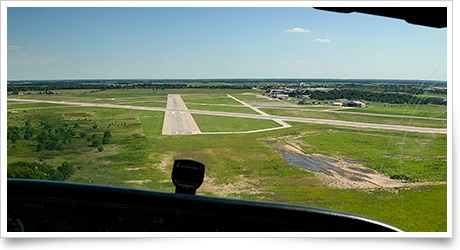| The following stories from the Mar. 23, 2012, edition of AOPA ePilot were provided to AOPA members who expressed an interest in the particular subject areas. Any AOPA member can receive information tailored to their areas of interest by updating their preferences online |
training tipsThe long-field method That’s not to say that a long runway comes without its unique set of demands and considerations. Arriving from the north at New Hampshire’s Portsmouth International Airport, you find that the general aviation apron is all the way at the opposite end. That’s a long taxi, so take your time and don’t rush things. The taxi route is straightforward; at some airports navigating a daunting ground route will go smoothly if you request progressive taxi instructions. What will you do if the winds are still out of the south when you depart? A full-length departure means taxiing all the way back to the departure end; if it is a warm day, be alert of any signs of overheating that closely cowled, air-cooled engine. (If your aircraft has cowl flaps, double check that you opened them after landing.) As an alternative, you may be offered—or could request—an intersection takeoff, and you may hear and observe other aircraft preparing to depart from various points along the runway. Discuss this scenario with your flight instructor for any specific solo cross-country, and follow up with a thorough study of the airport’s taxi diagram. The Air Safety Institute offers this page for looking up your destination’s diagram. Be sure you can locate and understand signs indicating how much runway distance remains from any intersection. When departing from an intersection, pay close attention to the departure path of aircraft taking off ahead of you—especially if they are airborne when they pass your location—for the wake turbulence they could generate. If an early turn on course is indicated for safety, request it from a departure controller, or commence it from a safe altitude after takeoff from a nontowered airport. Longer runways are convenient, confidence-inspiring features of many airports you will visit, but they don’t suggest that you should relax your vigilance or ease up on your piloting technique. training productsRadio Navigation Simulator app from Sporty’sIf VORs give you pause and you don’t know your distance measuring equipment (DME) from your automatic direction finder (ADF), practice is the key to mastering these navigation systems. Sporty’s Radio Navigation Simulator app shows a simulated instrument panel with a directional gyro and user-selectable course deviation indicator, radio magnetic indicator, ADF, and DME. Drag an airplane around the map, turn the OBS knob, change the map location, change navaid frequencies, and more. The app can be used on the iPhone, iPad, and iPod Touch. It sells for $9.95. See the website or call 800/776-7897.
Note: Products listed have not been evaluated by ePilot editors unless otherwise noted. AOPA assumes no responsibility for products or services listed or for claims or actions by manufacturers or vendors. final examQuestion: I am interested in flying to the Bahamas and I'm curious about what kind of fees I can expect to pay. Can you give me some information?
Answer: Landing fees are waived for single-engine aircraft at most government-owned airports, with the likely exception of Nassau and Freeport, as these airports are managed by an independent company. If you fly a twin, fees generally range from $5 to $15. Private airports will normally have landing or parking fees, as well. The FBOs (fixed-base operators) in Nassau and Freeport may also charge ramp fees; a quick call ahead of time is advised to determine the amount. The pilot and passengers each have to pay a $25 departure tax. For more information on flying to the Bahamas see AOPA’s website. Also check out an article on AOPA President Craig Fuller’s recent flight to the Bahamas, which includes tips for a great trip.
Got a question for our technical services staff? E-mail [email protected] or call the Pilot Information Center, 800/872-2672. Don’t forget the online archive of “Final Exam” questions and answers, searchable by keyword or topic. |
 Nothing beats making an arrival at an unfamiliar airport with an
Nothing beats making an arrival at an unfamiliar airport with an 

